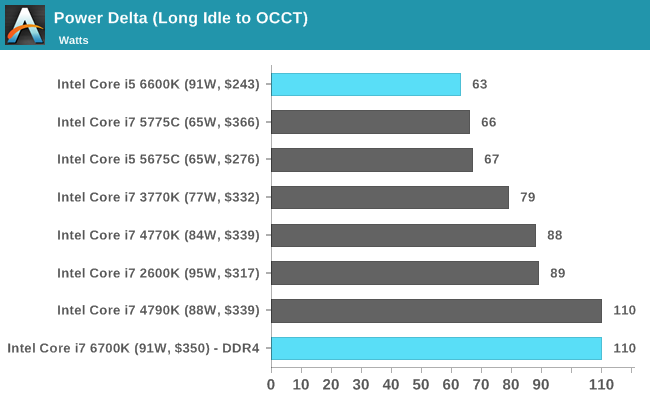But if, as you say, turbo speed is regulated by power rather than activity, this would still IMO favour the 6-core part given that it has less actual silicon to utilize.
The 6/12 would indeed have an inherent advantage over the 8/8, and here I can offer some of my own data collected to better understand how desktop Skylake chip behaves from a power usage perspective. The following table represents idle power usage for a 4/4 Skylake core. The numbers are slightly inflated because of a voltage bump my BIOS played on me, but they are nevertheless good enough to illustrate the situation (true "stock" voltage interval should be 0.81-1.15V).
Judging by this table, 2 Skylake cores sitting idle @ 4Ghz use around 3-4W while under 30C, so in in a hypothetical "warm" mainstream 8/8 Skylake CPU that would incur a 5-6W penalty (we consider the rest of them are doing real work and the chip goes turbo all the way up, so high frequency and high temps). Add some kind of light load and the penalty will increase, but then again once you put any real load on them it's hard to estimate when that load becomes lucrative, turning penalty into bonus.
Under some loads the 6/12 chip might end up with something like 6-10W of extra headroom, but then again this headroom will matter only as long as the 8/8 chip will have reached it's TDP limit. It seems to me the 6/12 chip might have the upper hand at 4-6 threads, loose between 7-10, then come back at 11-12 for a tie. Between 1-3 threads power usage should not affect max clocks.
After all, unless the SMT threads are under heavy load, they don't use noticeable power, and stacking background processes onto unused physical cores that are then not-quite-idle, rather than executing them simultaneously on an already in-use core at least sounds less efficient to me. That Intel consistently pushes SMT on mobile in low-power scenarios corroborates this, at least in my mind. If non-SMT was potentially more efficient for the same workload, we'd se far more 4C4T mobile CPUs out there.
It would be naive of me to come up with such an idea - that in general SMT is less efficient than adding cores. The cost alone of increasing chip area makes SMT a no brainer, but this is a unique situation where the chip maker creates the new chip by slashing features in the most advantageous way - a blend of cost optimization and fighting the competition.
In my view the 6/12 and 8/8, although offering different performance profiles, are too close in the end to warrant both SKUs, unless one of them is crippled in some way (binning, cache etc). However, it is my opinion that 8/8 would be more competitive against the 4/8 chip of the competition, which will have far better ST perf due to a combination of better IPC and higher clocks, but will start loosing steam after 4 threads and eventually tie towards 7 threads. (i made
another post on the matter on the Zen thread if you care to know my reasoning).
I should mention one more thing which I implied but never stated: my entire theory on 6/12 vs. 8/8 is based on the assumption that Zen, in it's first iteration, will have trouble efficiently clocking past 4Ghz. If this is not the case, and going past 4Ghz is not met with sharp power increase, then 6/12 will indeed have more wiggle room frequency wise, likely making it a better candidate than 8/8.




